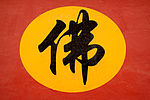| Part of a series on |
| Chinese Buddhism |
|---|
 |
| Part of a series on |
| Vajrayana Buddhism |
|---|
 |
Chinese Esoteric Buddhism refers to traditions of Tantra and Esoteric Buddhism that have flourished among the Chinese people. The Tantric masters Śubhakarasiṃha, Vajrabodhi and Amoghavajra, established the Esoteric Buddhist Zhenyan (Chinese: 真言, "true word", "mantra") tradition from 716 to 720 during the reign of Emperor Xuanzong of Tang. It employed mandalas, mantras, mudras, abhiṣekas, and deity yoga. The Zhenyan tradition was transported to Japan as Shingon Buddhism by Kūkai as well as influencing Korean Buddhism and Vietnamese Buddhism. The Song dynasty (960–1279) saw a second diffusion of Esoteric texts. Esoteric Buddhist practices continued to have an influence into the late imperial period and Tibetan Buddhism was also influential during the Yuan dynasty period and beyond. In the Ming dynasty (1368–1644) through to the modern period, esoteric practices and teachings became absorbed and merged with the other Chinese Buddhist traditions to a large extent.[citation needed]
In Chinese these traditions are also termed Mìjiao (Chinese: 密教; Esoteric Teaching), Mìzōng (密宗; "Esoteric Tradition") or Tángmì (唐密; "Tang (Dynasty) Esoterica").